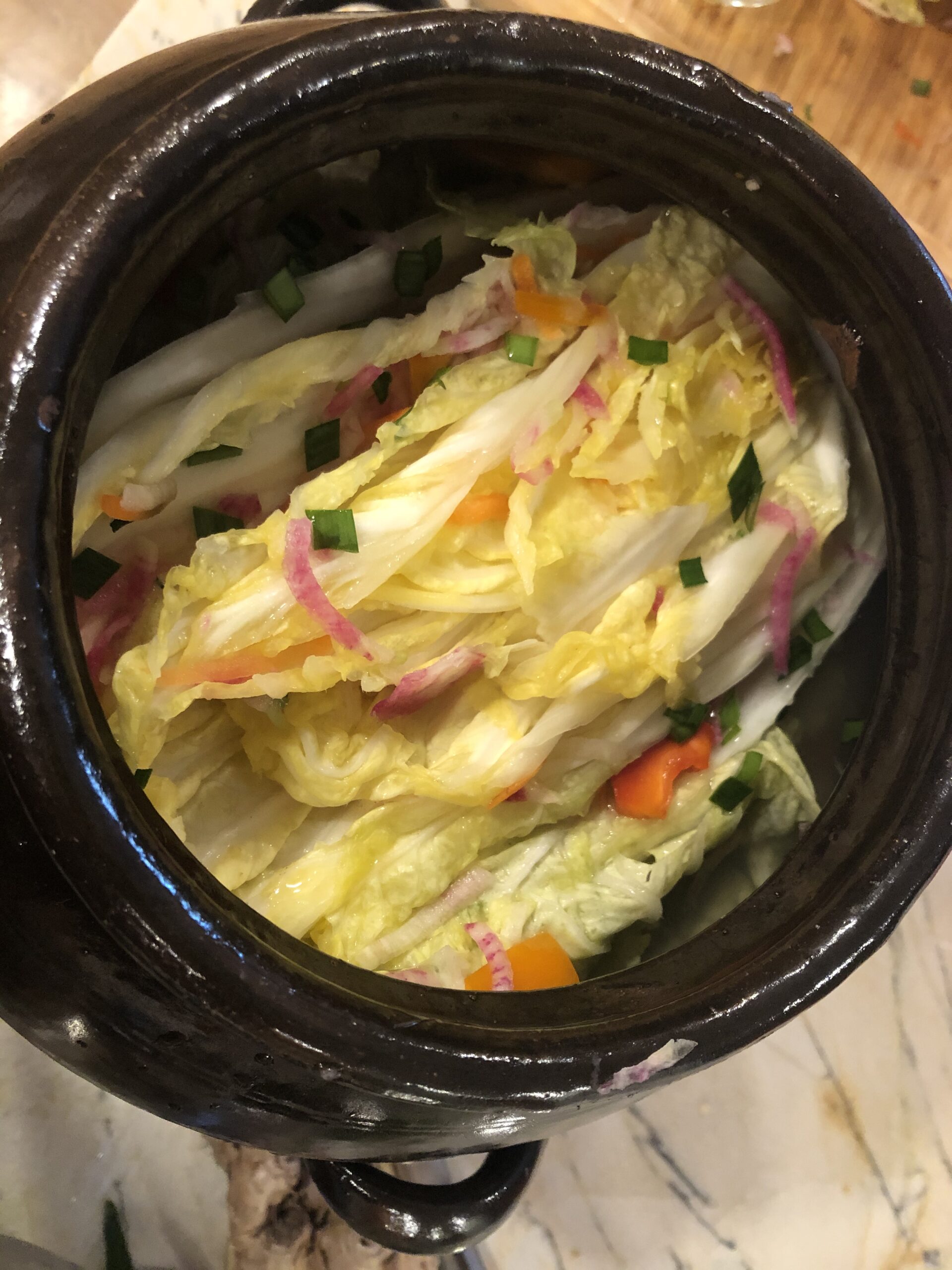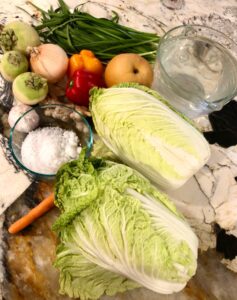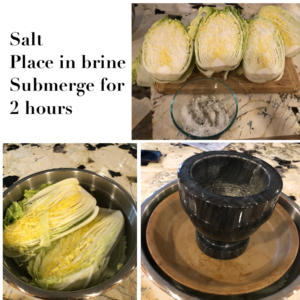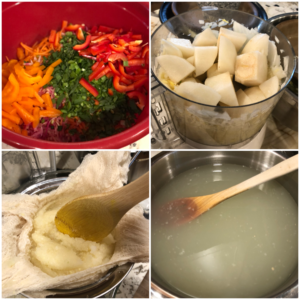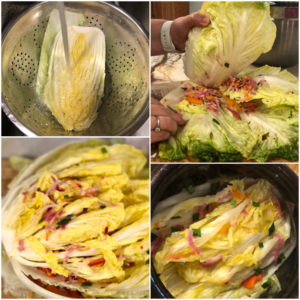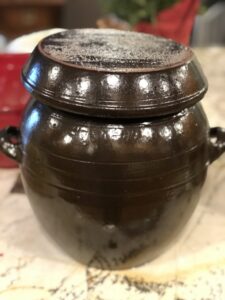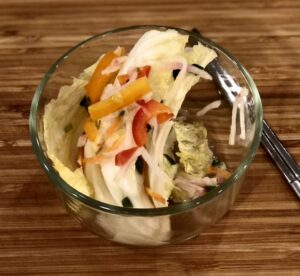BAEK KIMCHI- NON-SPICY WHITE KIMCHI
Betty Brown PRINT RECIPE
Vegan Recipe
Baek Kimchi is a delicious non-spicy pickled napa cabbage Baek means “white, “ and Kimchi means “fermented vegetable”.
Baek Kimchi is full of flavor, stuffed with colorful vegetables, and healthy ingredients without the spicy red chili peppers people often associate with kimchi. It can be served for any meals. It pairs especially well with grilled foods, rice, noodles and even or spicy dishes.
Because baek kimchi isn’t spicy and has a lower salt content, it’s a great option for people who have health concerns, and can’t tolerate spicy foods. Kids enjoy it as well.
Beak kimchi is good for vata, pitta and kapha dosha. It’s a great option for someone who’s pitta dosha may be out of balance ( indigestion, acne, plantar fasciitis, feeling intense). Fermented foods support digestion and are a good source of probiotics.
TOOLS:
Knife; Cutting boards; Large bowls; Colander; Onggi-Kimchi Crock, fermenting crock or mason canning jars; Mortar or fermenting weights; Spoons
INGREDIENTS:
- 1 large Napa cabbage (1.6 kg / 3.5 pounds)
- 1/4 cup coarse sea salt
Pickling brine
- 3/4 cups coarse sea salt or mineral salt
- 4 cups filtered water (warm water helps to dissolve salt)
- Combine these two ingredients, stir to make sure salt is dissolved prior to use
Kimchi brine
- 4 cups warm filtered water
- 1 Tbsp coarse sea salt (may substitute with Himalayan Salt )
- 1.5 lbs. Korean pear, bosc pear, Anjou pear or sweet crunchy apple such as honey crisp, ( or a combination) peeled and seeded, grated.
- 1 medium onion, peeled
- 4 large garlic cloves, peeled
- 1 inch fresh ginger root, roughly diced
- 1/2 inch fresh turmeric root, roughly diced (optional)
Kimchi fillings
- ½ large carrot, grated
- ½ lb Korean radish (Mu) daikon radish, turnip, kohlrabi, grated
- ½ cup Asian chives or garlic scapes, green onions, chopped about an inch in length.
- ½ of mediium red bell pepper, grated
- 4 fitted dried jujube , minced (optional, may substitute with dried white raisins)
- 1 Tbsp pine nuts (optional)
PREPARATION:
Prepare Napa Cabbage:
- Cut the cabbage into half. Then trim off the thick, hard base of Nappa cabbage.
- Sprinkle the salt directly on the white part of the cabbage and pour the pickling brine onto the cabbage. Place a heavy object such as a morter or weighted bowl onto the cabbage to stop the cabbage floating and to help with the pickling process.
- Leave it at room temperature until the white part of the cabbage is flexible, for 2 hours. Every 30 minutes turn the cabbage over .
- After 2 hours, rinse Napa cabbage in running water, rinsing off any residue salt. Drain and place on a strainer to drain off the water for 10 to 20 mins.
Prepare Kimchi Brine
- Mix warm filtered water and sea salt in a large bowl.
- Puree Korean pear, onion, garlic, ginger, turmeric in a blender. Place the blended ingredients into cheese cloth and tie/secure the top so that the food content doesn’t come out. Squeeze out all the juice from the cheese cloth into bowl with dissolved sea salt and water.
- Set bowl aside and compost food waste.
Prepare Kimchi Filling
- Mix together carrots, radish, chives, red bell peppers, jujube, and pine nuts in a bowl. And set aside.
Prepare Kimchi
- Place the pickled Napa cabbage onto a clean cutting board or large plate. . Starting from the bottom leaves, fill the cabbage with kimchi fillings, evenly, one layer of cabbage at a time. Once done, place the kimchi into a large container fermenting. Repeat this step with the remaining ingredients.
- Pour the Kimchi brine into the kimchi container. Place a heavy mortar or a plate on top to stop the kimchi floating and submerge the kimchi well in the brine. Close the lid. Leave at room temperature for 3 days then transfer into the fridge.
- Cut baek kimchi into smaller pieces and place in serving container. Enjoy the kimchi on day 3, or let it age for a few days. Serve the sliced kimchi on a plate and add a few scoops of the kimchi brine on top of the kimchi.
- Drink 1-2 oz brine after meals to support digestion. It tastes great!
Resources:
Benefits of Kimchi: https://www.healthline.com/nutrition/benefits-of-kimchi
Kimchi, a Fermented Vegetable, Improves Serum Lipid Profiles in Healthy Young Adults: Randomized Clinical Trial: https://www.ncbi.nlm.nih.gov/pmc/articles/PMC3598433/
Bioactive Compounds in Kimchi Improve the Cognitive and Memory Functions Impaired by Amyloid Beta: https://www.ncbi.nlm.nih.gov/pmc/articles/PMC6213637/
Best salts to make kimchi: https://www.ift.org/news-and-publications/news/2017/april/25/the-effects-of-mineral-rich-vs-purified-salt-in-kimchi
Fermentation Equipment:
Onggi-Kimchi Crock benefits: (purchase from Etsy, Amazon, or your local Asian grocer) https://www.researchgate.net/publication/230502600_Increased_quality_and_functionality_of_kimchi_when_fermented_in_Korean_earthenware_Onggi
History of Onggi:
http://www.koreanheritage.kr/interview/view.jsp?articleNo=121
Ingredients
Preparing the Napa cabbage
Preparing the kimchi filling and the kimchi brine
Rinsing and stuffing the Napa cabbage
